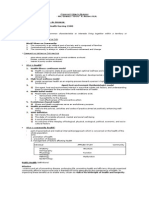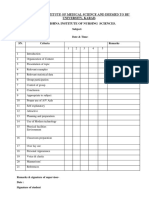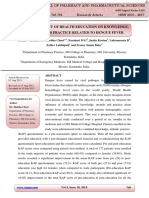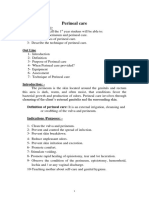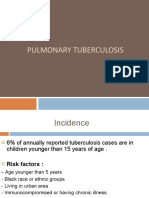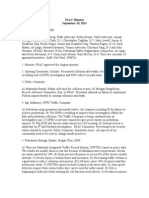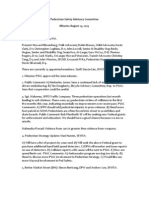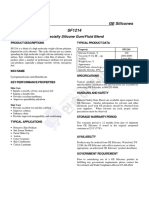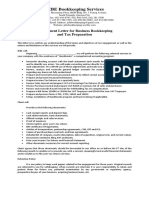Submission of Statement to House of Representatives in connection with hearing before Congressman Dennis Kucinich on September 25, 2008 on case
of brain tumor of Mr. Alan Marks in relation to his use of cell phones. I have been asked to present my assessment of the case for a cause-effect relationship between Mr. Alan Marks use of cell phones and the development spelled out below of his right sided frontal brain tumor, an oligodendroma (glioma) at least 10 years after first onset of use. The basis for my opinion is the review of his medical records, including the histologic diagnosis and the imaging of his tumor, the records of his cell phone use, an interview by phone with his wife, and the emerging prior epidemiologic evidence on the case for use of cell phones applied to the side of the head and brain cancer. History Mr. Marks was born in 1952. He suffered a seizure at age 56 (May 6, 2008) and was then found to have a Supplementary Motor Area tumor located in the right hemisphere (posterior right superior frontal gyrus). He is a right handed male with a history of behavioral problems for several years. Previously his health had been excellent, except for hypercholesterolemia, for which he was on medication. He is married and has 3 children. He has worked in the real estate industry most of his adult life. Prior neurological examination indicated motor weakness in left arm and leg. Imaging showed a non-enhancing frontal lesion in the right SMA. He underwent resection on June 16, 2008 with Dr. Mitchel Berger at UCSF. Most of the tumor was removed but fringe cells remain. It is an oligodnedroglioma WHO rated grade 2. He is being monitored with MRIs and when it grows back aggressively chemotherapy will be administered. Cell phone use: The family has provided me with information in Appendix 2. The family reports he was a heavy user of cell phones for at least 10 years with cumulative hours of conversation prior to his diagnosis estimated to be 2,020 minutes per month equaling over 400 hours of exposure per year, or more than hour of use per day over 10 years. The earliest record from ATT is from 1998 but he has used cell phones since they were first invented starting with a car phone. In the past 10 years and for years before, the phone was always 100% of the time held to the right ear where the tumor grew in the right frontal lobe. Discussion The weight of the evidence suggests it is more likely than not that there is a cause effect relationship between Marks heavy cell phone use over a ten year period and his brain tumor. It is more likely than not that these exposures were either the primary or
�contributory cause. The basis for this statement is as follows; The fact that the brain tumor appeared after a ten year latent period and on the right side is consistent with the emerging body of knowledge on exposure and effect and latency and laterality of cell phone use. This body of knowledge is summarized in Hardell et als latest paper in Occupational and Environmental Medicine and the Bioinitiative Report. Although evidence suggests that there is an increased risk especially after 10 y of latency, we cannot exclude the possibility that even when latency is under 10 y for certain individuals with very high exposures. We have reported individual cases of brain cancer in young radar workers with induction periods < 10 y. There is no alternative explanation for the tumor at a relatively young age in this patient. Comment Mr. Marks episode, taken together with the emerging epidemiologic knowledge pointing to a cause-effect relationship between cell phone use and brain cancer, is a sentinel event calling for application of preventive measures to reduce population exposures, especially to children, from cell phone use. Are we on the threshold of an epidemic of brain cancer associated with a world wide experiment in which a source of non-ionizing radiation is held right next to the head? We cannot give an affirmative answer to the above question with certainty, but is it wise to continue on with the mass experiment on hundreds of millions of people in the light of the advancing knowledge? It is this concern which was the basis for the Benevento Resolution in 2006 calling for the application of precautionary strategies to prevent and protect by reducing exposure. This resolution stated that there is accumulating epidemiologic evidence indicating there is an increased brain tumor risk from long term use of cellular phones. Since then the evidence in support of this statement continues to accumulate. In retrospect, there were indications that such risks were present even in the earliest studies by Hardell et al in early 2000s. Indeed, even studies reported as negative, when closely examined, showed evidence of increased risk associated with laterality and increased latency. In conclusion, I share with the Committee a set of answers in response to questions from the attorney of a patient with a brain tumor following prolonged cell phone use in Israel. What are the dangers associated with the use of cellular telephones? The best available knowledge is that use of cell phones is associated with increases in risks for brain tumors, (gliomas, gliobastomas, acoustic neuromas) and most recently, parotid gland tumors. There are also reports of other effects on neurobehavioral function.
�What are the studies describing the risks? The Bioinitiative Report summarizes studies showing increased risks for brain tumors associated with increased latency of use and side of use. These results are seen not only in those in which the authors interpret the results as indicative of a positive association, i.e all those by Hardell) but also in those interpreted as negative (e. g. Shoemaker). Reviews by Hardell and Kundi and others examine these results. Are there cellular changes in the body from EMF? There is much experimental work showing that exposure to Non Ionizing Radiation results in cellular changes. This information is summarized in the Bioinitiatve report. These include effects on cell communication,, DNA changes, membrane permeability and other effects. But there are few studies on cell phones per se. Are there high risk subgroups? Children: There is concern that children, with softer skulls, more rapidly developing tissues, and a longer shelf life, are considered to be at greater risk than others. This concern is the basis for precautionary recommendations cautioning against the unrestricted use of cell phones by children. Use of cell phones by children should be limited to the barest minimum. Pregnant women and their fetuses: Information is not readily available on risks from use of cell phones by pregnant women on themselves or their fetuses. However a new study of 13,000 mothers, just published in Epidemiology in July 2008, reports a link between use of handsets and later behavioral problems in children. Scientists found that mothers who did use the handsets were 54 per cent more likely to have children with behavioural problems and that the likelihood increased with the amount of potential exposure to the radiation. The problems included hyperactivity and difficulties with conduct, emotions and relationships by the time they reached school age. The risks were greater if the children themselves used the phones before the age of seven. Occupation: Szmigielski and others shown dose related increases in risks associated with occupational exposures to non-ionizing radiation from radar frequencies. Our own paper has reported a cluster of high risk in a group of soldiers with estimated heavy exposures to non-ionizing radiation in work with masts used for radar surveillance What are the prospects for future risks? We can say with increasing degrees of certainty that there are increased risks for brain cancer (gliomas and acoustic neuromas) associated with intense and prolonged use of cell phones and cordless phones. We cannot say with absolute certainty what the thresholds of use and intensity are for absence of risk.
�In general, the findings show that risks for cancer are associated with longer latency and duration of use. Massive increase in cell phone use has created a situation of population wide exposure to cell phones. Several years were required to elapse before there were was detectable evidence on risks from the first generation of analog phones. With Digital phones, which came into use several years later, it is premature to say they are without risk. At present, there seems a suggestion of a trend towards upward creep in risk in subgroups with longer latencies in studies having longer follow up. (See the Shoemaker study). It is disturbing that the complete findings of the Interphone study and its primary databases have yet to be fully released. The public health concern is that small increases in relative risk applied to hundreds of millions of users will translate into a huge increase in absolute numbers of victims of brain cancer. How should we reduce risk? There is much that can be done at the level of personal protection. Stricter SAR standards, use of loudspeakers so as to increase distance of the cell phone from the head, less use, and more distance, use of a loudspeaker for all practical purposes should substantially reduce or eliminate nearly all the risk at the individual level. But more fundamentally, there is a need for policies at the community level to protect the public by prevention, i.e. reducing dependence on cell phone use. Everything should be done to ban attempts to get rid of public land line phones in public places. It is time for policy makers to require warnings concerning the use of cell phones, the risks from cell phones being held next to the body when turned on but not in use, the risks from cordless phones, and special need for precaution concerning the use of cell phones and cordless phones by children.. It is time for policy makers to apply precautionary strategies to prevent risk by reducing exposures and it is time for the public to protect itself by reducing its use of cell phones and to prevent publicby reducing exposures. Sincerely, Professor Elihu D Richter MD, MPH Note: The website, www.CABTA.org, prepared by the Marks family, has an excellent compendium of material, including the latest Hardell article








